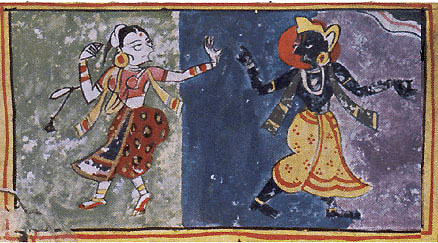Jaur Gita Govinda
BY: SUN STAFF

Nov 11, USA (SUN) — Amongst the nectar ocean of Vaisnava literatures, the Gita-Govinda has had a phenomenally pervasive influence on the World. Gita-Govinda has been distributed far and wide by way of more than a hundred published editions, along with a vast wealth of extant source materials including epigraphical records, commentaries, translations and imitative paintings.
Gita-Govinda illustrations have been undertaken by artists in practically every school of miniature painting in India. These miniatures can be found across India and Nepal, but not generally in Kashmir or the South They date from the mid-fifteenth century to the late nineteenth century.
More than 1,500 unpublished manuscripts have been identified by researchers. Hundreds more, if not thousands, of depictions of this literary jewel are also found in music, dance, drama, poetics, and ornamentation of various kinds.
In the Sun's Gita-Govinda series, we will explore the Jaur Gita-Govinda, a manuscript acquired in 1976 by the National Museum in New Delhi. Our series is derived from a study of Jaur Gita-Govinda by Kapila Vatsyayan for the National Museum.
An illustrated Gujarati manuscript, the Jaur Gita-Govinda dates from the 16th century, being dated 1650 Samvat (1593 A.D.). Jaur Gita-Govinda is written in Devanagari script, and comprises 30 folios, with 28 illustrations.
Jaur Gita-Govinda's text is written in prose, rather than following the patterns of sargas and prabandhas of Jayadeva's Gita-Govinda. This version is modeled on an older Mewari manuscript, and it appears to hold an important place in the evolution of early Rajasthani painting.
The text translations here cannot be taken as absolute, since they have not been translated or purported by our own Sampradaya Acaryas. However, a close academic version of each folio's bhavas (sentences or sections) is presented as literally as possible. At the least, they convey enough of the narrative to make viewing the manuscript illustrations a rich experience.
The narrative of Jaur Gita-Govinda reads like a dialogue between its three main characters: Srimati Radharani, her close associate Sakhi, and Lord Sri Krsna. Together, these transcendental personalities manifest the waves of separation and reunion which move the heart of rasa lila.
Over the next month, we will present daily excerpts of text and illustrations from the 30 folios of Jaur Gita-Govinda, which we hope our readers will relish and enjoy discussing.

Text Folio No. 1
The first line pays obeisances to Sri Krsna and Ekalinga, and describes the work as letters based on the Gita-Govinda. The narration begins from line 2, onwards:
Bhava 1
One day Radha Ji at the behest of Baba Nanda escorted Sri Bhagavan (i.e. Krsna). On the way, on the banks of the Yamuna, began the amoda pramoda (the loving dalliance called moda-mangala here) and the two were involved in a lovely lila.
Bhava 2
After Sri Bhagavan had satiated himself, he embraced Sri Radha (alingana): the passionate love-play filled Radha with the divine aroma of Sri Krsna's being. He is addressed as Sri Ji throughout the work.
Bhava 3
Bhava 3 begins with an adoration of Sri Krsna and speaks of him as the giver of infinite joy to the disabled, the sick and others, including the beautiful maidens. Even the murmuring bees rejoice at the mention of his name. While the text of this folio describes the beginning of the journey of Krsna and Radha and speaks of Nanda's order as in the verses of the Gita-Govinda, there is no reference here either to the overcast sky or to the poet Jayadeva, as in the original Gita-Govinda, nor is there a reference to the Dasavatara theme The text also reverses the order of the Sritakamala verses.

Illustration Folio No. 2
The illustration is clearly divided into two horizontal areas. The upper register depicts the dasavataras in small rectangular squares; the lower shows Krsna and Radha in an embrace, with a cow on either side. The dasavataras panel begins with a figure of Ganesa and is followed by a four armed Matsya, Kurma, Narasimha, Vamana, Parasurama, Rama, Buddha, Varaha, Krsna and Kalki, in that order. The background color of the panels, yellow (pita or blue syama), depicts incarnations that are either 'human' or half-man, half-animal. We see the Krsna-Balarama incarnation depicted as Venugopala, and Kalki as a rider-less horse.
It is obvious that the whole of the first sarga has been compressed together, both in the text and the illustration. While the text makes no mention of the dasavataras, the pictorial depiction quite clearly follows the Gita-Govinda verses, although it does not follow the order of the incarnations strictly.
The figures of Radha and Krsna are placed against a dark blue background, which separates them out from the rest of the painting surface. This background alone suggests the overcast sky. The red halo around Krsna's head is used throughout the manuscript to identify him.
See a larger image of the Illustration

